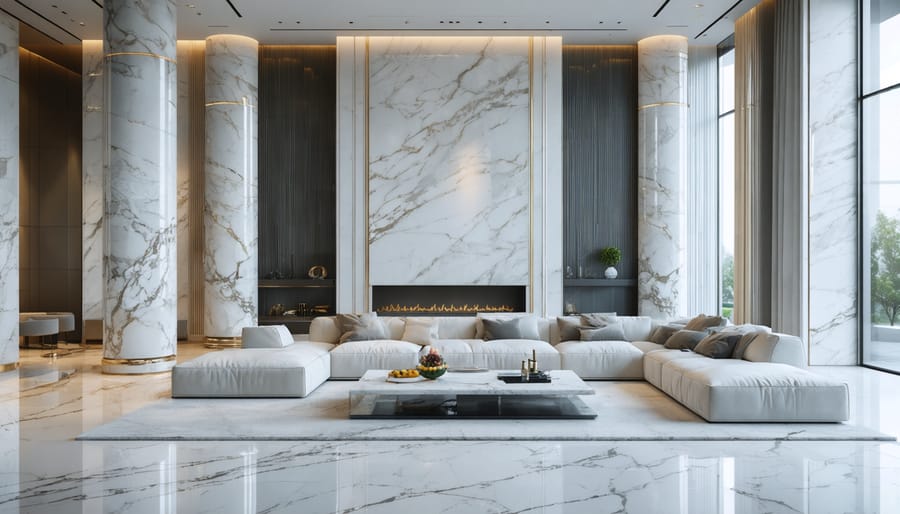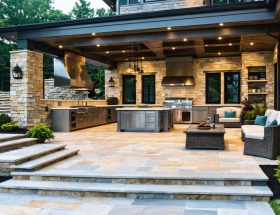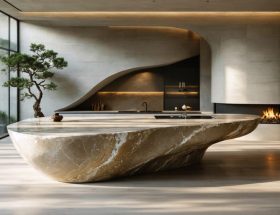Interior stone columns transform ordinary spaces into timeless architectural masterpieces, seamlessly blending classical grandeur with modern design sensibilities. As one of today’s most sought-after sustainable architectural elements, these majestic features deliver both structural support and unparalleled aesthetic impact, elevating interior designs from mundane to magnificent.
Natural stone columns represent the perfect marriage of form and function, offering durability that spans centuries while creating dramatic focal points that command attention. Whether supporting grand entryways, defining living spaces, or adding architectural interest to commercial interiors, these enduring elements bring an air of sophistication and permanence that manufactured materials simply cannot match.
Modern applications of interior stone columns range from traditional fluted Corinthian designs to sleek contemporary interpretations, providing architects and designers with versatile options for any style preference. Their ability to bridge historical architecture with contemporary design makes them an increasingly popular choice for both residential renovations and new commercial construction projects.
The Timeless Appeal of Interior Stone Columns
Structural vs. Decorative Applications
Interior stone columns serve two distinct purposes in modern architecture: structural support and decorative enhancement. Structural columns are load-bearing elements that play a crucial role in supporting the building’s weight and maintaining its structural integrity. These columns must be engineered precisely and installed according to strict building codes and specifications.
In contrast, decorative columns are purely aesthetic installations designed to add architectural character and visual interest to interior spaces. While they don’t bear structural loads, they can dramatically transform a room’s appearance. Many homeowners opt for stone veneer alternatives for decorative columns, which provide the elegant look of natural stone without the structural requirements and weight considerations of solid stone.
Understanding this distinction is crucial when planning your interior design project. Structural columns require professional engineering and installation, while decorative columns offer more flexibility in terms of placement, material selection, and installation methods. Both types can be finished with various stone materials to achieve the desired aesthetic, but their core construction and installation requirements differ significantly.

Popular Stone Types for Interior Columns
Natural stone columns offer timeless elegance, with several popular options suited for interior applications. Marble remains a top choice, prized for its distinctive veining patterns and broad color palette ranging from classic white Carrara to dramatic black Marquina. Its polished finish creates a luxurious appearance perfect for formal spaces and grand entrances.
Limestone provides a more understated elegance with its uniform texture and warm, neutral tones. This versatile stone works exceptionally well in both traditional and contemporary settings, offering excellent durability and a natural matte finish that ages beautifully over time.
Granite stands out for its exceptional strength and durability, making it ideal for load-bearing columns. Available in countless colors and patterns, from speckled to solid, granite resists scratches and wear while maintaining its polish. Its crystalline structure creates subtle depth and sparkle under lighting.
Other notable options include travertine, known for its distinctive natural pitting and cream to brown tones, and onyx, which offers translucent properties that allow for dramatic backlit installations. Each stone type brings unique characteristics that can enhance your interior design vision while providing lasting structural beauty.

Design Considerations and Placement
Scale and Proportion
Selecting the right dimensions for interior stone columns requires careful consideration of your space’s proportions and architectural style. The classical order provides time-tested guidelines, with column height typically ranging from 8 to 10 times the diameter at the base. For residential spaces with standard 8-foot ceilings, columns usually measure 6 to 8 inches in diameter, while grander spaces with higher ceilings may require diameters of 12 inches or more.
When planning column placement, maintain a minimum distance of 6 feet between columns to ensure comfortable traffic flow. The space between columns, known as the intercolumniation, should be proportional to their height and the room’s dimensions. For optimal visual balance, consider the rule of thirds: divide your ceiling height by three to determine an appropriate column spacing.
Load-bearing requirements also influence column dimensions. While decorative columns can be more slender, structural columns must meet specific engineering requirements. Always consult local building codes and structural engineers when determining dimensions for load-bearing applications. Remember that proper scaling ensures your stone columns appear neither too imposing nor too delicate for the space they occupy.
Strategic Placement Options
Strategic placement of interior stone columns can dramatically enhance a room’s architectural impact while maintaining functional flow. In grand entryways, paired columns create a striking first impression and naturally guide visitors through the space. For open-concept areas, columns can serve as elegant room dividers, defining distinct zones without compromising the overall spaciousness.
When positioning columns in living spaces, consider creating symmetrical arrangements that frame key features like fireplaces or large windows. In dining rooms, columns work beautifully as corner elements, adding gravitas without interrupting traffic patterns. For larger spaces, a colonnade effect can be achieved by placing columns in a linear arrangement, creating a classical gallery feel.
Scale plays a crucial role in placement decisions. Allow approximately 6-8 feet of clearance between columns and walls for optimal visual balance. In smaller rooms, single statement columns can serve as focal points, while larger spaces may benefit from grouped arrangements. Consider sight lines from primary viewing angles and ensure columns complement rather than obstruct important architectural features or views.
Remember that natural light interaction affects how stone columns are perceived, so position them where they can catch and reflect light effectively throughout the day.
Complementary Design Elements
Stone columns achieve their full potential when thoughtfully integrated with complementary design elements. Creating harmonious interior design requires careful consideration of surrounding materials and features. Natural wood flooring or trim can soften the stone’s formality while enhancing its organic qualities. Consider pairing columns with coordinating stone elements like fireplace surrounds or accent walls to create visual continuity throughout the space.
Lighting plays a crucial role in highlighting stone columns’ texture and character. Strategic placement of uplighting or wall sconces can create dramatic shadows and emphasize the column’s architectural details. Crown molding and baseboards should complement the column’s style, whether classical or contemporary, to ensure a cohesive look.
When selecting furniture and décor, choose pieces that respect the columns’ scale and presence. Avoid overcrowding the space around columns, allowing them to serve as natural focal points. Textiles and wall colors in complementary or contrasting tones can help integrate the columns into your overall design scheme while maintaining their distinctive presence.
Installation and Maintenance
Professional Installation Requirements
Installing interior stone columns requires professional expertise and careful planning to ensure structural integrity and aesthetic excellence. Following established stone installation best practices is crucial for a successful project.
The installation process typically begins with a thorough structural assessment to verify the floor can support the column’s weight. Professionals will establish precise measurements and create a detailed installation plan, considering factors like load-bearing requirements and architectural alignment.
A proper foundation must be prepared, usually involving reinforced concrete footings. The installation team will use specialized equipment to lift and position the stone components, ensuring perfect vertical alignment. Each section must be carefully leveled and secured using appropriate bonding materials and mechanical fasteners where necessary.
For sectional columns, precise matching of veining patterns and color consistency is essential. Skilled craftsmen will carefully align each piece to create seamless transitions between sections. The installation also requires proper waterproofing and sealing to protect the stone from moisture and staining.
The final steps include applying appropriate sealants and performing quality checks to ensure stability and aesthetic perfection. Only certified stone installers should attempt this work, as errors can lead to safety hazards and costly repairs.

Long-term Care and Preservation
Regular maintenance and proper care are essential for preserving the beauty and structural integrity of interior stone columns. Start with a quarterly inspection to check for any signs of damage, cracks, or wear. Clean the columns monthly using a pH-neutral stone cleaner and a soft microfiber cloth, avoiding harsh chemicals or abrasive materials that could damage the stone’s surface.
Apply a high-quality stone sealer every 2-3 years to protect against staining and moisture penetration. The frequency may vary depending on the stone type and environmental conditions. In high-traffic areas, consider more frequent sealing to maintain protection.
Temperature and humidity control play crucial roles in stone preservation. Maintain consistent indoor climate conditions, as extreme fluctuations can cause stone expansion and contraction, potentially leading to cracks. Keep relative humidity between 45-55% to prevent moisture-related issues.
Address any spills immediately to prevent staining, and avoid placing potted plants directly on stone surfaces, as water seepage can cause discoloration. For marble and limestone columns, use coasters under decorative items to prevent etching from acidic substances.
Professional restoration services are recommended every 5-10 years, depending on wear and tear. This may include deep cleaning, repairs, and refinishing to maintain the column’s original luster and structural integrity. Keep detailed maintenance records to track treatments and schedule future care.
Cost Considerations and ROI
Installing interior stone columns represents a significant investment that can substantially impact your property’s value and aesthetic appeal. Initial costs typically range from $1,500 to $5,000 per column, depending on size, material choice, and complexity of installation. Natural stone options like marble and granite command premium prices, while manufactured stone alternatives can reduce costs by 30-40% while maintaining visual appeal.
The return on investment (ROI) for interior stone columns is particularly favorable in luxury properties and high-end renovations. Real estate professionals estimate that well-designed stone columns can contribute to a 5-15% increase in property value, especially in formal spaces like grand entryways and living rooms. This value appreciation tends to be more pronounced in upscale neighborhoods where architectural details are highly prized.
When calculating total costs, consider additional expenses beyond the columns themselves. Installation typically requires professional expertise, adding $500-1,500 per column. Structural reinforcement may be necessary, particularly for heavier natural stone options, potentially adding 10-20% to the base cost. Regular maintenance costs are relatively minimal, averaging $100-200 annually for cleaning and sealing.
To maximize ROI, focus on quality materials and professional installation. While initial costs may be higher, premium materials and expert craftsmanship ensure longevity and better value appreciation. Consider the architectural style of your property when selecting column designs – classical styles tend to offer the most consistent return on investment, particularly in traditional or transitional homes.
Remember to factor in long-term durability when comparing options. Natural stone columns, while more expensive initially, often last for decades with minimal maintenance, making them cost-effective over time.
Interior stone columns represent a timeless investment in architectural elegance and structural sophistication. Throughout this guide, we’ve explored the various types of stone columns available, from classic marble to rustic limestone, and their transformative impact on interior spaces. Whether you’re considering columns for their structural support or purely decorative purposes, proper planning, professional installation, and regular maintenance are crucial for long-term success. By carefully weighing factors such as stone selection, placement, and budget considerations, you can create stunning architectural statements that enhance your interior’s aesthetic appeal while potentially increasing your property’s value. Remember that working with experienced professionals and quality materials will ensure your stone columns remain beautiful and functional for generations to come.










